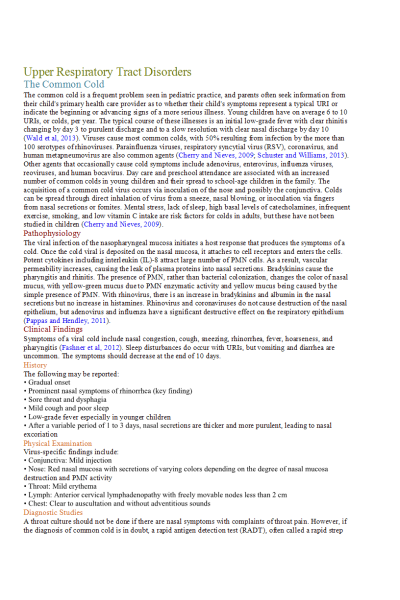Upper Respiratory Tract Disorders
The Common Cold
The common cold is a frequent problem seen in pediatric practice, and parents often seek information from their child's primary health care provider as to whether their child's symptoms represent a typical URI or
indicate the beginning or advancing signs of a more serious illness. Young children have on average 6 to 10 URIs, or colds, per year. The typical course of these illnesses is an initial low-grade fever with clear rhinitis changing by day 3 to purulent discharge and to a slow resolution with clear nasal discharge by day 10 (Wald et al, 2013). Viruses cause most common colds, with 50% resulting from infection by the more than
100 serotypes of rhinoviruses. Parainfluenza viruses, respiratory syncytial virus (RSV), coronavirus, and human metapneumovirus are also common agents (Cherry and Nieves, 2009; Schuster and Williams, 2013). Other agents that occasionally cause cold symptoms include adenovirus, enterovirus, influenza viruses, reoviruses, and human bocavirus. Day care and preschool attendance are associated with an increased number of common colds in young children and their spread to school-age children in the family. The acquisition of a common cold virus occurs via inoculation of the nose and possibly the conjunctiva. Colds can be spread through direct inhalation of virus from a sneeze, nasal blowing, or inoculation via fingers from nasal secretions or fomites. Mental stress, lack of sleep, high basal levels of catecholamines, infrequent exercise, smoking, and low vitamin C intake are risk factors for colds in adults, but these have not been studied in children (Cherry and Nieves, 2009).
Pathophysiology
The viral infection of the nasopharyngeal mucosa initiates a host response that produces the symptoms of a cold. Once the cold viral is deposited on the nasal mucosa, it attaches to cell receptors and enters the cells. Potent cytokines including interleukin (IL)-8 attract large number of PMN cells. As a result, vascular permeability increases, causing the leak of plasma proteins into nasal secretions. Bradykinins cause the
pharyngitis and rhinitis. The presence of PMN, rather than bacterial colonization, changes the color of nasal mucus, with yellow-green mucus due to PMN enzymatic activity and yellow mucus being caused by the simple presence of PMN. With rhinovirus, there is an increase in bradykinins and albumin in the nasal secretions but no increase in histamines. Rhinovirus and coronaviruses do not cause destruction of the nasal epithelium, but adenovirus and influenza have a significant destructive effect on the respiratory epithelium (Pappas and Hendley, 2011).
Clinical Findings
Symptoms of a viral cold include nasal congestion, cough, sneezing, rhinorrhea, fever, hoarseness, and pharyngitis (Fashner et al, 2012). Sleep disturbances do occur with URIs, but vomiting and diarrhea are
uncommon. The symptoms should decrease at the end of 10 days.
History
The following may be reported:
• Gradual onset
• Prominent nasal symptoms of rhinorrhea (key finding)
• Sore throat and dysphagia
• Mild cough and poor sleep
• Low-grade fever especially in younger children
• After a variable period of 1 to 3 days, nasal secretions are thicker and more purulent, leading to nasal excoriation
Physical Examination
Virus-specific findings include:
• Conjunctiva: Mild injection
• Nose: Red nasal mucosa with secretions of varying colors depending on the degree of nasal mucosa destruction and PMN activity
• Throat: Mild erythema
• Lymph: Anterior cervical lymphadenopathy with freely movable nodes less than 2 cm
• Chest: Clear to auscultation and without adventitious sounds
Diagnostic Studies
A throat culture should not be done if there are nasal symptoms with complaints of throat pain. However, if the diagnosis of common cold is in doubt, a rapid antigen detection test (RADT), often called a rapid strep
test, should be done with a throat culture if the RADT is negative (Shulman et al, 2012).
Differential Diagnosis
The most common differentials are allergic rhinitis, rhinosinusitis, and adenoiditis (Table 32-2).
Management
Only supportive care is needed for a viral URI. See the Basic Respiratory Management Strategies section and see Box 32-1 for guidance regarding the use of decongestants, antihistamines, and cough medications.
Antibiotics are not appropriate treatment. The child should receive symptomatic relief for fever, pain, and nasal congestion using normal saline and an antipyretic. Although topically applied menthol may improve nighttime cough, there is a risk of chemical irritation and accidental ingestion, causing CNS and gastrointestinal (GI) side effects. Fluid intake should be encouraged.
Complications
Common colds are self-limiting, but secondary bacterial infections including otitis media, pneumonia, and sinusitis can occur along with secondary wheezing.
Pharyngitis, Tonsillitis, and Tonsillopharyngitis
Pharyngitis is an inflammation of the mucosa lining the structures of the throat, including the tonsils, pharynx, uvula, soft palate, and asopharynx. It can be due to infectious agents or noninfectious causes,such as smoke or other air irritants. The illness is generally acute and involves an inflammatory response,including erythema, exudate, or ulceration.
The etiology could include a number of viruses and bacteria. If there are nasal symptoms, it is called nasopharyngitis, but if there are no nasal symptoms, the disease is called pharyngitis or tonsillopharyngitis.
Most cases of pharyngitis are caused by viruses (Gereige and Cunill-De Sautu, 2011). Adenovirus is the most common cause of nasopharyngitis (Cherry, 2009c). Other viruses include Epstein-Barr virus (EBV),
herpes simplex virus (HSV), cytomegalovirus (CMV), enterovirus, influenza virus, parainfluenza, and human immunodeficiency virus (HIV). The viral organisms generally present with upper nasal symptoms.
The common bacterial etiology is GABHS in children between 5 and 11 years old, whereas 40% of reported cases of gonococcal infections occur in females 15 to 19 years old. Other organisms include Corynebacterium diphtheriae, Arcanobacterium haemolyticum, Neisseria gonorrhoeae, group C and group G streptococci, Chlamydia
trachomatis, Francisella tularensis, and Mycoplasma pneumonia (Gereige and Cunill-De Sautu, 2011).....................document continue
| Instituition / Term | |
| Term | Spring 2020 |
| Institution | Chamberlain |
| Contributor | Lopez |

-80x80.png)


















-80x80.png)
-80x80.png)








-80x80.png)























